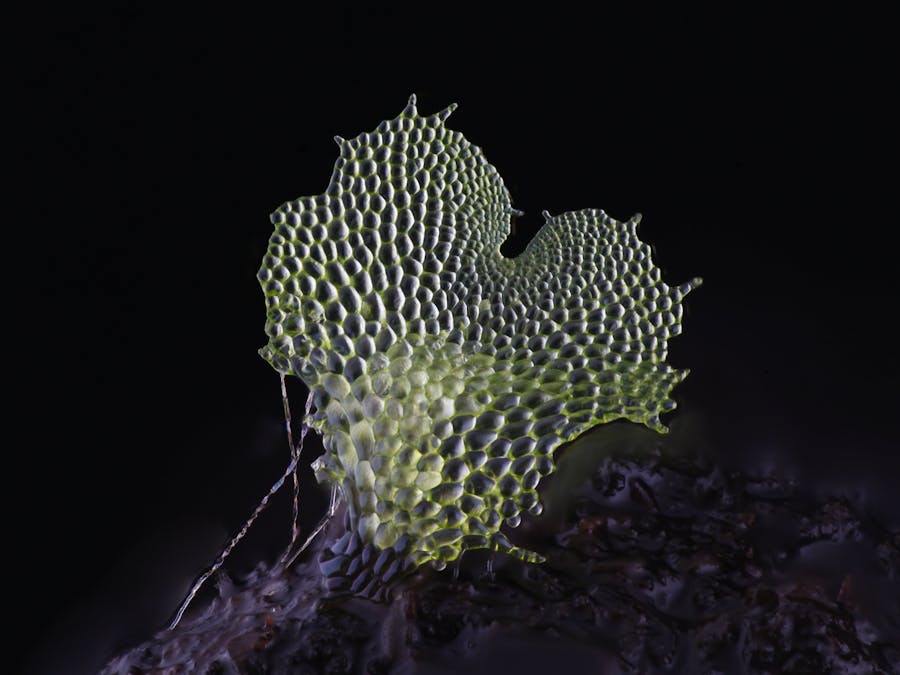This is part of my project on photographing gametophytes ferns using focus stacking.
What is a gametophyte fern?Just in case you're curious, here is a layperson's explanation of what a gametophyte fern is. If you would like to know how to grow them, then please scroll down.
The plant below is a gametophyte fern.
Figure 1.
It is only about half a centimetre across, and it will never get very much bigger than 1 cm. What is it though, and how does it relate to the big ferns (like the one below) that we are more familiar with from our gardens?
Figure 2.
Ferns are not quite like people in their mode of their reproduction. They have a system called "alternation of generation". In this system, a tiny gametophyte plant (Figure 1) reproduces to make a new large sporophyte plant (Figure 2). Then the large sporophyte plant reproduces to make a new tiny gametophyte plant. And round they go again, alternating between sporophyte and gametophyte for ever.
The two plants are both individuals in their own right, and they can live entirely independently of one another. What are these sporophytes and gametophytes though?
A sporophyte fern is a large plant that produces spores. The spores can be seen clustered on the underside of the leaves of ferns that we meet in the garden. These spores each have only one set of chromosomes. When they fall off the leaves of the large sporophyte fern, they land on the ground and develop into tiny gametophyte plants.
The tiny gametophyte plants have only one set of chromosomes in each of their cells. The plants never grow much larger than a centimetre across and at maturity (a few weeks or months) they produce egg and sperm cells which also only have one set of chromosomes. The sperm cell swims across the plant's surface and possibly even onto an adjacent plant, until it finds an egg cell and fertilises it. This fertilisation event produces a cell with two sets of chromosomes, which then goes on to develop into a large sporophyte fern plant.
It always astonishes me that something as deceptively simple as a fern has such a complicated life cycle. It actually includes two completely different kinds of plants, which take turns in living their lives.
Since some sporophyte ferns are large trees, this alternation of generation is the size equivalent of a skyscraper giving birth to a shoe, which then gives birth to a new skyscraper. It's pretty odd, and pretty amazing. What's more, the process has been going on quietly and successfully for many many more years than human reproduction, in spite of its complexity.
How to grow them.Growing gametophyte fern is great fun. Here is how I grow them.
- Fill a completely clean plastic plant pot with peat-based compost (like Jack's Magic), leaving about 2 cms between the rim of the pot and the top of the soil.
- Pour a lot of boiling water through the compost to thoroughly sterilise it (Figure 3, below).
- Cover the pot with cling film or a freezer bag to exlude air-borne spores and leave to drain.
- Put the pot into a sealed freezer bag and then put into the fridge to cool.
- When cool, sow spores thinly on the surface of the compost and then reseal the freezer bag (Figure 4, below). Spores should be sown very thinly to get good photographic specimens. The best way that I have found is to have the spores on a piece of paper and then lightly flick the paper so that the spores shoot into the air and float down onto the compost.
- Put the pot near a window but not in a place where it will be exposed to direct sunlight. The pot should not be above normal room temperature. For example, an airing cupboard would be too hot.
- Germination takes several weeks, and there may still be problems with fungal contamination, so it is best to have several pots growing at once so that at least one pot is likely to be free of fungus.
- When the spores germinate the gametophytes will be extremely hard to see at first. They just look like tiny fragments of diamond dust with a green tint.
Figure 3
Figure 4





Comments
Please log in or sign up to comment.